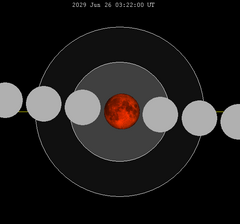| Total Lunar Eclipse June 4, 1993 | |
|---|---|
| (No photo) | |
 The moon passes west to east (right to left) across the Earth's umbral shadow, shown in hourly intervals. | |
| Series | 130 (33 of 72) |
| Duration (hr:mn:sc) | |
| Totality | |
| Partial | |
| Penumbral | |
| Contacts | |
| P1 | UTC |
| U1 | |
| U2 | |
| Greatest | |
| U3 | |
| U4 | |
| P4 | |
A total lunar eclipse took place on Friday, June 4, 1993, the first of two total lunar eclipses in 1993, the second being on Monday, November 29. The Moon was plunged into darkness for 1 hour and 36 minutes, in a deep total eclipse which saw the Moon 56% of its diameter inside the Earth's umbral shadow. The visual effect of this depends on the state of the Earth's atmosphere, but the Moon may have been stained a deep red colour. The partial eclipse lasted for 3 hours and 38 minutes in total. The moon passed through the center of the Earth's shadow.
YouTube Encyclopedic
-
1/1Views:811
-
Upcoming Solar Eclipse Meditations From Various People And Websites
Transcription
Visibility
It was seen completely over Australia, seen rising over Asia on the evening of Friday 4 June 1993, and setting over Western North and South America on the morning of Friday 4 June 1993.
Related eclipses
Eclipses of 1993
- A partial solar eclipse (north) on May 21.
- A total lunar eclipse (central, passing north of the axis) on June 4.
- A partial solar eclipse (south) on November 13.
- A total lunar eclipse (south) on November 29.
Lunar year series
| Lunar eclipse series sets from 1991–1994 | ||||||||
|---|---|---|---|---|---|---|---|---|
| Ascending node | Descending node | |||||||
| Saros | Date Viewing |
Type Chart |
Gamma | Saros | Date Viewing |
Type Chart |
Gamma | |
| 110 | 1991 Jun 27
|
Penumbral
|
−1.40641 | 115 | 1991 Dec 21
|
Partial
|
0.97094 | |
| 120 | 1992 Jun 15
|
Partial
|
−0.62887 | 125 |
1992 Dec 9
|
Total
|
0.31438 | |
| 130 | 1993 Jun 4
|
Total
|
0.16376 | 135 |
1993 Nov 29
|
Total
|
−0.39941 | |
| 140 | 1994 May 25
|
Partial
|
0.89334 | 145 | 1994 Nov 18
|
Penumbral
|
−1.10479 | |
| Last set | 1991 Jul 26 | Last set | 1991 Jan 30 | |||||
| Next set | 1995 Apr 15 | Next set | 1995 Oct 08 | |||||
Saros series
Lunar saros series 130, repeating every 18 years and 11 days, has a total of 71 lunar eclipse events including 56 umbral lunar eclipses (42 partial lunar eclipses and 14 total lunar eclipses). Solar Saros 137 interleaves with this lunar saros with an event occurring every 9 years 5 days alternating between each saros series.
| Greatest | First | |||
|---|---|---|---|---|
 The greatest eclipse of the series will occur on 2029 Jun 26, lasting 102 minutes.[1] |
Penumbral | Partial | Total | Central |
| 1416 Jun 10 | 1560 Sep 4 | 1921 Apr 22
|
1957 May 13
| |
| Last | ||||
| Central | Total | Partial | Penumbral | |
2083 Jul 29
|
2155 Sep 11 | 2552 May 10 | 2678 Jul 26 | |
| 1903 Apr 12 | 1921 Apr 22 | 1939 May 3 | |||

|

|

|

|

|

|
| 1957 May 13 | 1975 May 25 | 1993 Jun 4 | |||

|

|

|

|

|

|
| 2011 Jun 15 | 2029 Jun 26 | 2047 Jul 7 | |||

|

|

|

|

|

|
| 2065 Jul 17 | 2083 Jul 29 | ||||

|

|

|

| ||
Half-Saros cycle
A lunar eclipse will be preceded and followed by solar eclipses by 9 years and 5.5 days (a half saros).[2] This lunar eclipse is related to two annular solar eclipses of Solar Saros 137.
| May 30, 1984 | June 10, 2002 |
|---|---|

|

|
See also
Notes
- ^ Listing of Eclipses of cycle 130
- ^ Mathematical Astronomy Morsels, Jean Meeus, p.110, Chapter 18, The half-saros
External links
- Saros cycle 130
- 1993 Jun 04 chart Eclipse Predictions by Fred Espenak, NASA/GSFC




